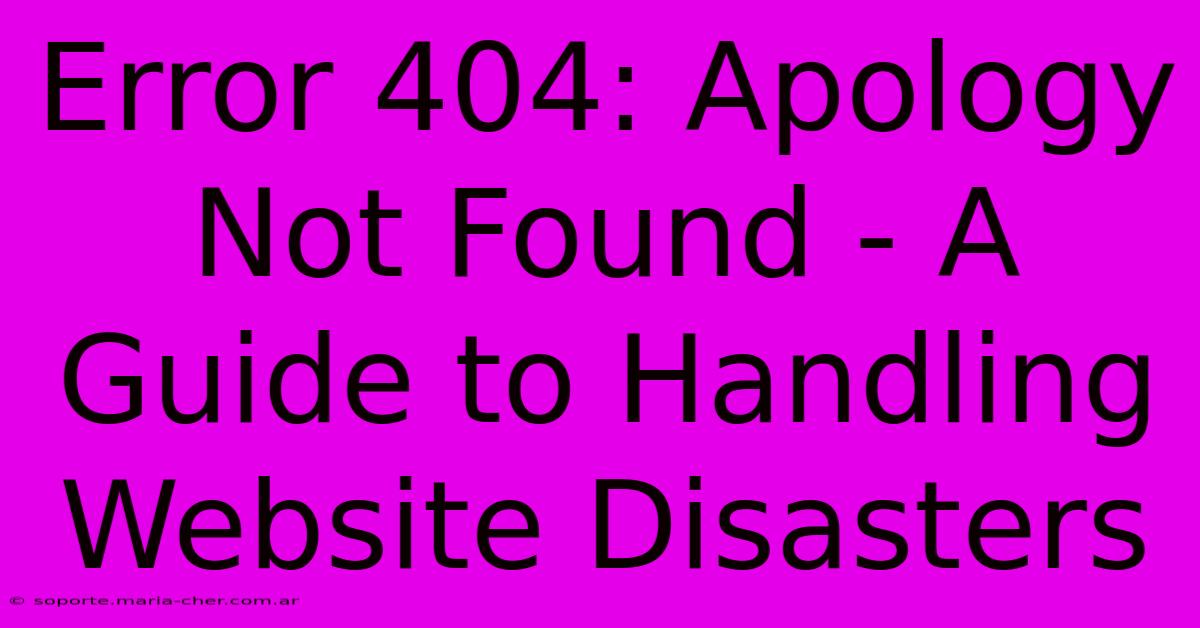Error 404: Apology Not Found - A Guide To Handling Website Disasters

Table of Contents
Error 404: Apology Not Found - A Guide to Handling Website Disasters
The dreaded 404 error. That stark, unfriendly message telling users they've reached a dead end. It's a website disaster waiting to happen, capable of tanking your user experience, damaging your SEO, and ultimately, hurting your bottom line. But fear not! This guide will arm you with the knowledge and strategies to not only fix 404 errors but to turn this potential catastrophe into an opportunity to improve your website.
Understanding the 404 Error: What's the Problem?
A 404 error, or "Not Found," occurs when a user clicks a link (internal or external) that leads to a page that no longer exists. This can happen for various reasons:
- Deleted pages: You might have removed content, reorganized your site, or updated URLs.
- Broken links: Internal links on your site, or external links from other websites, might be pointing to incorrect addresses.
- Typos in URLs: A simple misspelling can send users straight to the 404 abyss.
- Server-side issues: Problems with your website's server can also lead to 404 errors.
The Impact of 404 Errors: More Than Just a Minor Inconvenience
Ignoring 404 errors is a recipe for disaster. Their consequences can be significant:
- Lost users and conversions: Frustrated users are likely to bounce, never to return. This directly impacts your conversion rates.
- Damaged SEO: Search engines dislike broken links. A high number of 404 errors can negatively affect your search engine rankings.
- Poor user experience: A cluttered website with numerous broken links creates a negative impression, potentially driving away potential customers.
How to Find and Fix 404 Errors: A Proactive Approach
Don't wait for users to report 404 errors. Take a proactive approach:
1. Regularly audit your website:
Utilize website crawlers (both free and paid options exist) to automatically scan your site for broken links. These tools identify 404 errors and provide detailed reports. Consider tools like Screaming Frog or similar options.
2. Check your website analytics:
Tools like Google Analytics provide valuable data on 404 errors. Look for reports showing the pages generating the most 404s. This data gives you insights into which links need immediate attention.
3. Review your sitemap:
Ensure your sitemap is up-to-date and reflects the current structure of your website. An outdated sitemap can lead to search engines indexing broken links.
4. Implement 301 redirects:
If you've deleted a page, create a 301 redirect (permanent redirect) to a relevant page on your site. This ensures users (and search engines) are directed to a suitable alternative, preserving valuable SEO juice.
5. Double-check all links:**
Regularly review internal and external links on your website. Pay close attention to links in your navigation menus, sidebars, and footers. Ensure they lead to the correct pages.
Turning 404 Errors into Opportunities: The Custom 404 Page
Instead of a bland "Page Not Found" message, create a custom 404 page that's both informative and engaging. This can significantly improve the user experience and even boost your brand image.
Here's how to make your 404 page work for you:
- Keep it user-friendly: Clearly indicate the error and provide a simple explanation.
- Offer solutions: Provide a search bar, links to your homepage, and popular pages to help users navigate your site.
- Add a touch of humor or personality: A creative, engaging 404 page can be memorable and even create positive brand associations.
- Track performance: Monitor your custom 404 page's performance to ensure it's effective in guiding users back to relevant content.
Preventative Measures: Long-Term Solutions
Preventing 404 errors is key to maintaining a healthy website. Consider these strategies:
- Careful content management: Before deleting pages, plan carefully and implement redirects.
- Regular link checks: Make link checking part of your regular website maintenance routine.
- Use a CMS with good link management: Many CMS platforms offer tools to manage links effectively and detect broken links.
- Collaborate with others: If you use external links, communicate with website owners to ensure links remain active.
By actively addressing 404 errors and implementing these preventative measures, you can transform a potential website disaster into a smooth, user-friendly online experience. Don't let those 404s haunt your website – conquer them and watch your online presence flourish.

Thank you for visiting our website wich cover about Error 404: Apology Not Found - A Guide To Handling Website Disasters. We hope the information provided has been useful to you. Feel free to contact us if you have any questions or need further assistance. See you next time and dont miss to bookmark.
Featured Posts
-
Settings Simplified Unravel The Mystery Behind Categories
Feb 04, 2025
-
Chill Like A City Boss How City Refrigerators Conquer The Urban Heat
Feb 04, 2025
-
Create A Rich And Inviting Atmosphere With American Gold
Feb 04, 2025
-
The Future Of Nail Art Get Ready For The Revolution With Dnd Gel 268
Feb 04, 2025
-
Hollywood Heist Neon Signs Leak Secret Sale Codes For Movie Tickets
Feb 04, 2025
